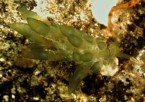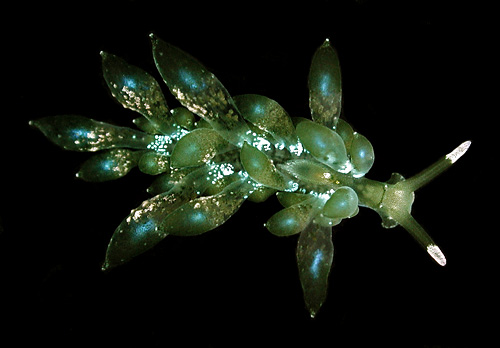| Home |
| Acknowledgments |
| Conventions |
| Glossary |
| Maps |
| References |
| Links |
| Articles |
| Thumbnails |
| Species
list |
| Family |
| Next
species |
Additional Photos

on rock

Sacoproteus sp. #1

| Maximum size: 15 mm. Identification: This is a relatively large, olive-green species with spindle-shaped, slightly iridescent cerata. The distal portions of the cerata are darker green and their inner surfaces are weakly tuberculate with white flecks. The rhinophores are tipped with white and there is a dark olive-green line running across the head between the eye spots. Natural history: Sacoproteus sp. #1 is a rare species known from only three animals found in tide pools at rocky, highly exposed sites. (Note 1) Distribution: Maui and Oahu: may be widely distributed in the Pacific. (Note 2) Taxonomic notes: It was first recorded in Hawaii from Mokolea, Maui by PF on April 24, 1994. The relatively small number of greatly elongate, tapering cerata appear to distinguish it from other Sacoproteus spp. illustrated in Krug, et. al. (2018). The closest match in cerata form might be S. yhiae but that species has noticeably more cerata. Photo: PF: 11 mm: Mokolea Point, Maui; April 24, 1994. Observations and comments: Note 1: On Sept. 30, 2000 two animals were found in an algae wash from a tide pool at Makapu`u Point, Oahu. The wash included extensive patches of Caulerpa taxifolia as well as smaller amounts of C. seratularioides and C. racemosa. Later, the animals showed no interest in pieces of those algae when they were offered in a dish. These animals weren't photographed but, from memory, were consistent with Pauline's animal. The elongate cerata suggest that it might be mimicking the elongate lateral branchlets of C. taxifolia and/or C. seratularioides. Note 2: There's some uncertainty in lumping the Hawaiian population with other similar photos from elsewhere in the Pacific. |
| Thumbnails |
Species
list |
Family | Next species | Top |